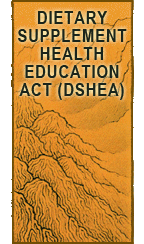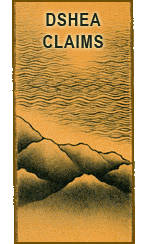Dietary Supplement Health Education Act Tutorial

In October 1994, the Dietary Supplement Health and Education Act (DSHEA) was signed into law by President William Jefferson Clinton. Before this time, dietary supplements were subject to the same regulatory requirements as were other foods. This new law, which amended the Federal Food, Drug, and Cosmetic Act, created a new regulatory framework for the safety and labeling of dietary supplements. [Source]
From DSHEA came a series of rules, and guidelines on how dietary supplements should design their labeling and any other publications in support of a given dietary supplement. Many TCM practitioners have begun to sell herbal products online. The vast majority of which rely on copying label conventions from each other.
 Last modified: September 1, 2009 ·
Last modified: September 1, 2009 ·  al ·
al ·  Comments Closed
Comments Closed
 Tags: Claims, DSHEA, Labeling · Posted in: DSHEA
Tags: Claims, DSHEA, Labeling · Posted in: DSHEA
DSHEA Tutorial: Claims Defined

One of the most difficult parts of DSHEA to comprehend is the difference between all of the claims that are made, what we can say, what we can’t say, when the disclaimer is required, and so forth.
The first thing that we need to do is understand the difference between the different “claims”.
Health Claims (aka Disease Claims)
Qualified Health Claims
Nutrient Content Claims
Structure/Function Claims
 Last modified: August 22, 2009 ·
Last modified: August 22, 2009 ·  al ·
al ·  No Comments
No Comments
 Tags: Claims, DSHEA · Posted in: Claims
Tags: Claims, DSHEA · Posted in: Claims
DSHEA Tutorial: Structure & Function Claims

Structure / Function claim: This is where we get in to those “promotes healthy bowel movements” type statements. We can’t fix diarrhea, but we can promote healthy bowel movements. Say it loud, say it proud, we can promote healthy bowel movements! But don’t forget to say it to the FDA too, before 30 days have passed.
They want to know what structure / function claims are being made. You don’t have to prove your claims are true, but they do require that you can maintain some sort of proof on file just in case the subject should come up at a later date. Specifically the “substantiation” that needs to be kept on file is that your claims are truthful and not misleading.
 Last modified: August 21, 2009 ·
Last modified: August 21, 2009 ·  al ·
al ·  No Comments
No Comments
 Tags: Claims, DSHEA · Posted in: Claims
Tags: Claims, DSHEA · Posted in: Claims
DSHEA Tutorial: Definition Of Disease

Structure / Function claims don’t seem to be too difficult to come up with. The hard part is avoiding disease claims while making your product’s label or marketing materials compelling. So, let’s get clear on what a disease claim is.
The FDA uses the NLEA (Nutrition Labeling and Education Act) definition of “disease or health related condition”.
damage to an organ, part, structure, or system of the body such that it does not function properly (e.g., cardiovascular disease), or a state of health leading to such dysfunctioning (e.g., hypertension); except that diseases resulting from essential nutrient deficiencies (e.g., scurvy, pellagra) are not included in this definition
 Last modified: August 20, 2009 ·
Last modified: August 20, 2009 ·  al ·
al ·  No Comments
No Comments
 Tags: Claims, DSHEA · Posted in: Claims
Tags: Claims, DSHEA · Posted in: Claims
DSHEA Tutorial: Disease Definition Exceptions

Summary: the FDA has set aside a few conditions that, while considered temporarily inconvenient, are not considered a disease. The complete list is found lower on this page.
Are there any exceptions to these disease claim issues?
Of course, it works like this. If you are claiming to help with something that may be no big deal or in fact could be a big deal, the tie goes to the runner, which in this case is us!
 Last modified: August 19, 2009 ·
Last modified: August 19, 2009 ·  al ·
al ·  No Comments
No Comments
 Tags: Claims, DSHEA · Posted in: Claims
Tags: Claims, DSHEA · Posted in: Claims
DSHEA Tutorial: Claim Disclaimer

Whenever you make a structure / function claim, you have to add a disclaimer that explains how the claim has not been evaluated by the FDA, and that it isn’t supposed to treat a disease.
The actual disclaimer reads as the following:
This statement has not been evaluated by the Food and Drug Administration. This product is not intended to diagnose, treat, cure, or prevent any disease.
 Last modified: August 18, 2009 ·
Last modified: August 18, 2009 ·  al ·
al ·  No Comments
No Comments
 Tags: Claims, DSHEA · Posted in: Claims
Tags: Claims, DSHEA · Posted in: Claims
DSHEA Tutorial: Website Labeling

Summary: free speech allows one to make any statement about the actions of an herbal formula that are accurate and truthful. However, when those statements are associated with an adjacent purchase opportunity such as a “buy now” button on a web page, the statement becomes a “claim”.
There are plenty of places where you can make claims that need to comply with DSHEA standards.
The first is kind of obvious, that’s the bottle’s label or the packaging in which the herbs are found.
Next we have any papers, advertisements, coupons, or other materials packaged with your supplement that you sell, mail, provide, or otherwise get to the consumer. All of these things are considered “labeling”, but it doesn’t stop there.
 Last modified: August 17, 2009 ·
Last modified: August 17, 2009 ·  al ·
al ·  No Comments
No Comments
 Tags: Claims, DSHEA · Posted in: Claims
Tags: Claims, DSHEA · Posted in: Claims
DSHEA Tutorial: Disease Claim Non-Compliant Workarounds

This page articulates the various situations in which the FDA is going to consider labeling a disease claim. Keep in mind too that even with what you see on this page, the FDA guidance keeps mentioning “context” in regards to how they read a claim. There’s more on that later.
I call these non-compliant workarounds. The most obvious attempt to circumvent the disease claim rule is by giving a formula a name that implies a treatment for a disease such as “Tumor-Shrink”. Although the name of a formula isn’t a claim, the attempt to make a claim is obvious. What follows on this page are the various ways in which hard working folks like you and I try to work around the FDA’s rules. These are non-compliant, so don’t use these ideas, they won’t work. Get it?
 Last modified: August 16, 2009 ·
Last modified: August 16, 2009 ·  al ·
al ·  No Comments
No Comments
 Tags: Claims, DSHEA · Posted in: Claims
Tags: Claims, DSHEA · Posted in: Claims
DSHEA Tutorial: TCM Disease Terms Replacing WM Terms

Non-Compliant Workaround #1: claiming to treat a disease by replacing the disease name with slang or TCM syndrome names.
Summary: you don’t have to mention a recognizable biomedical disease to be making a disease claim. Even TCM patterns in which something is wrong that that needs to be made right are considered diseases.
 Last modified: August 15, 2009 ·
Last modified: August 15, 2009 ·  al ·
al ·  No Comments
No Comments
 Tags: Claims, DSHEA · Posted in: Claims
Tags: Claims, DSHEA · Posted in: Claims
DSHEA Tutorial: “Cure” Versus “Support”

Non-Compliant Workaround #2: verbs or terms that describe the function of the formula that suggests the treatment of disease.
For instance, “Shen Ling Bai Zhu San to restore normal colon function” suggests that the colon’s function is in a diseased state and must be restored, and so this statement would be non-compliant. “Shen Ling Bai Zhu San to maintain healthy function of the colon” is okay. “Shen Ling Bai Zhu San to prevent diarrhea” is non-compliant. Treating, curing, preventing or mitigating disease is something that only drugs can do, not dietary supplements.
 Last modified: August 14, 2009 ·
Last modified: August 14, 2009 ·  al ·
al ·  No Comments
No Comments
 Tags: Claims, DSHEA · Posted in: Claims
Tags: Claims, DSHEA · Posted in: Claims
